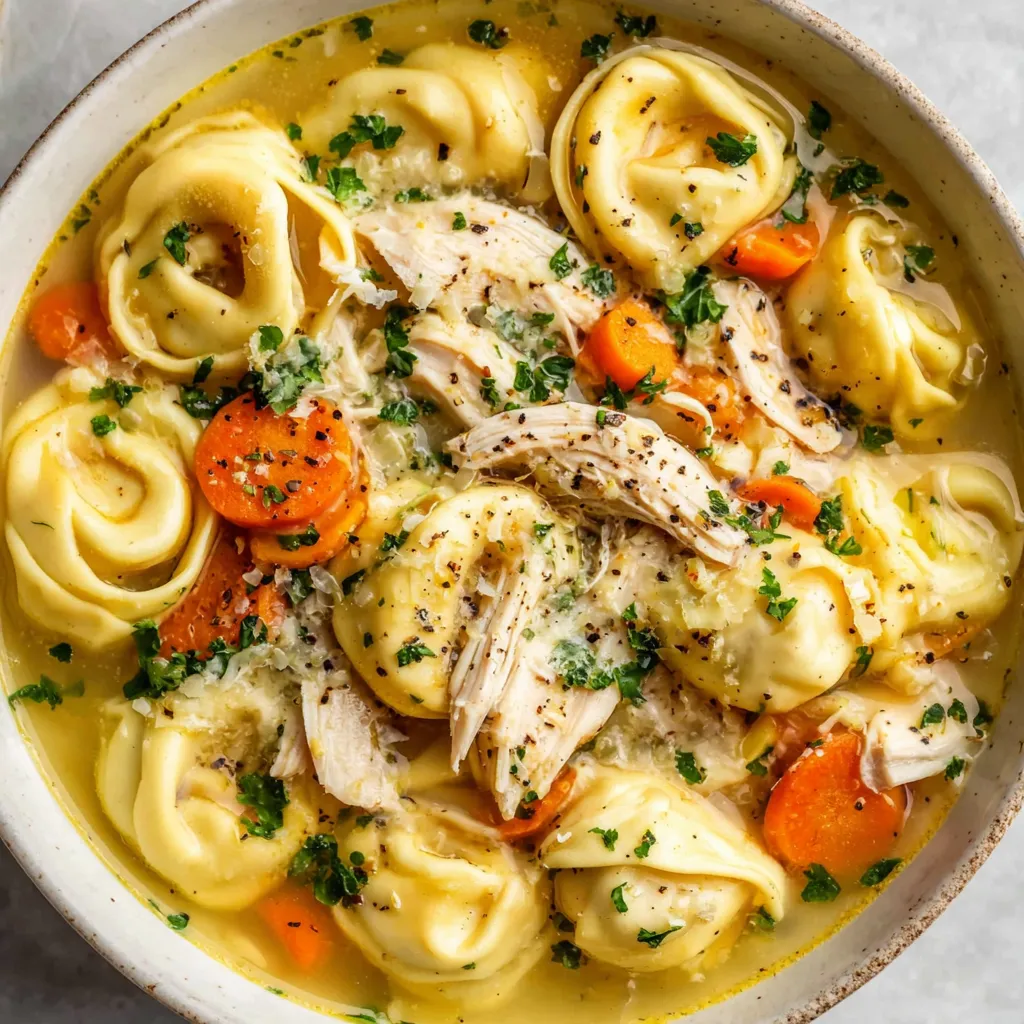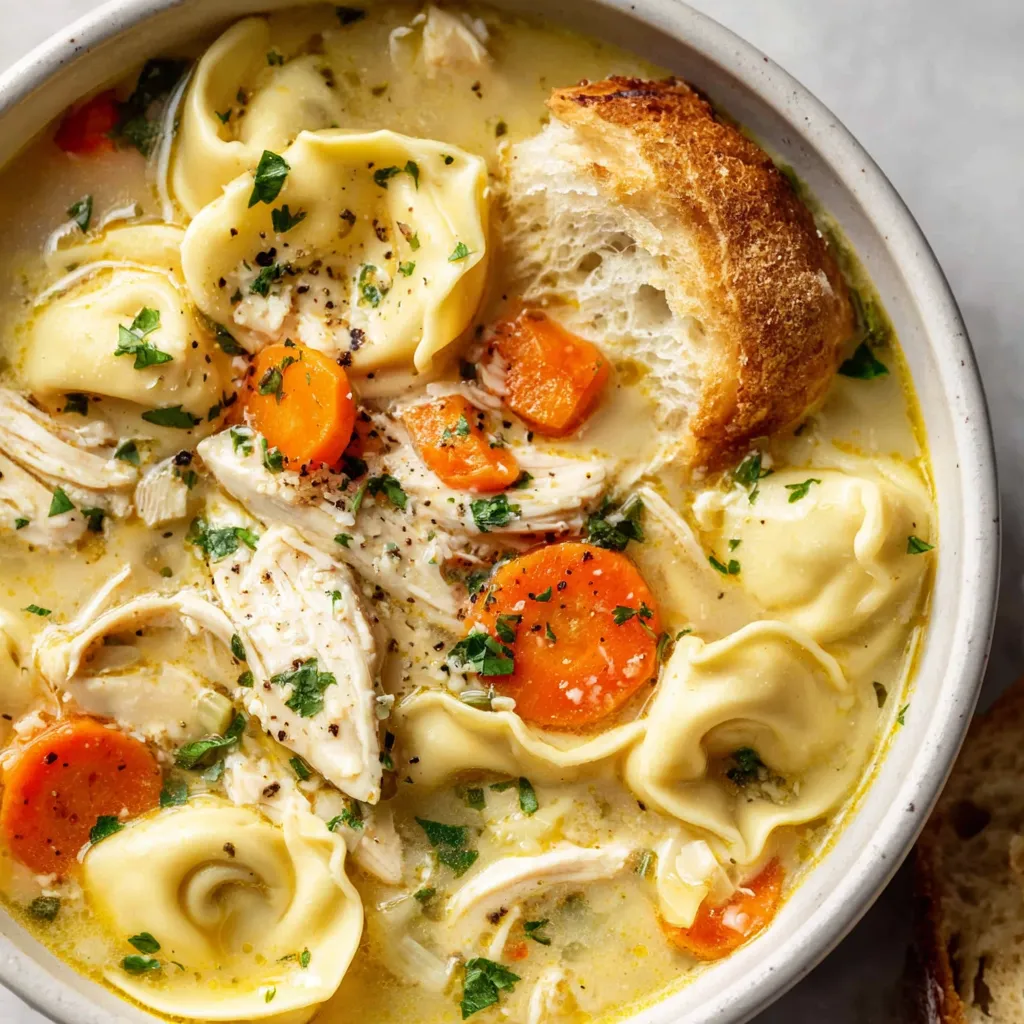Unlocking Flavor: The Science Behind a Stellar Soup
 At its heart, Chicken Tortellini Soup is a balance of flavors and textures. The key players are: the broth (the foundation), the chicken (protein and flavor depth), the tortellini (carbohydrate and textural interest), and the vegetables (freshness and complexity).
At its heart, Chicken Tortellini Soup is a balance of flavors and textures. The key players are: the broth (the foundation), the chicken (protein and flavor depth), the tortellini (carbohydrate and textural interest), and the vegetables (freshness and complexity).
- Broth Brilliance: A rich, homemade chicken broth is undeniably superior. However, a good quality store-bought broth can work. Look for low-sodium options to control the saltiness. The gelatin in the broth provides body and richness.
- Chicken Considerations: Pre-cooked rotisserie chicken is a fantastic shortcut, but remember that it’s already seasoned. Adjust your salt levels accordingly. Raw chicken thighs, simmered in the broth, yield incredibly flavorful results, but require more cooking time.
- Tortellini Tactics: Fresh tortellini cooks much faster than dried. Overcooking leads to a gummy, unpleasant texture. Add the tortellini towards the end of the cooking process, just until they’re tender. Cheese tortellini is classic, but chicken or spinach tortellini can add another layer of flavor.
- Vegetable Vibrancy: Sautéing vegetables like onions, carrots, and celery (the classic mirepoix) before adding them to the broth unlocks their sweetness and complexity. Don’t skip this step!
The Ultimate Chicken Tortellini Soup Recipe
This recipe is the culmination of my experiments, failures, and “Aha!” moments. It’s designed to be foolproof, adaptable, and utterly delicious.Ingredients:
- For the Soup:
- 1 tablespoon olive oil
- 1 medium yellow onion, chopped
- 2 carrots, peeled and chopped
- 2 celery stalks, chopped
- 4 cloves garlic, minced
- 8 cups chicken broth (low sodium preferred)
- 1 teaspoon dried Italian seasoning
- 1/2 teaspoon dried thyme
- 1/4 teaspoon red pepper flakes (optional)
- 1 pound cooked chicken, shredded (rotisserie chicken works great)
- 9 ounces fresh cheese tortellini
- 1 (14.5 ounce) can diced tomatoes, undrained
- 1 cup chopped fresh spinach
- Salt and black pepper to taste
- Fresh parsley, chopped (for garnish)
- Grated Parmesan cheese (for garnish)
Instructions:
- Sauté the Vegetables: Heat olive oil in a large pot or Dutch oven over medium heat. Add onion, carrots, and celery and cook until softened, about 5-7 minutes. Add garlic and cook for another minute until fragrant.
- Build the Broth: Pour in chicken broth, Italian seasoning, thyme, and red pepper flakes (if using). Bring to a simmer.
- Add Chicken and Tomatoes: Add shredded chicken and diced tomatoes (with their juices) to the pot. Simmer for 10 minutes to allow the flavors to meld.
- Cook the Tortellini: Add tortellini to the soup and cook according to package directions, usually about 3-5 minutes, or until tender. Be careful not to overcook.
- Stir in Spinach: Stir in spinach until wilted, about 1 minute.
- Season and Serve: Season with salt and black pepper to taste. Ladle into bowls and garnish with fresh parsley and grated Parmesan cheese.
Variations:
- Creamy Soup: Stir in 1/2 cup of heavy cream or half-and-half at the end for a richer soup.
- Vegetable Boost: Add other vegetables like zucchini, bell peppers, or mushrooms.
- Spicy Kick: Add a pinch of cayenne pepper or a dash of hot sauce for extra heat.
- For an interesting flavor profile, consider adding a splash of lemon juice at the end.
My Tortellini Trek: The Soup Saga
My first few attempts were a disaster. I used too much salt, the tortellini turned to mush, and the broth tasted like…well, nothing. But I persevered, driven by the desire to create a truly exceptional Chicken Tortellini Soup.Broth Blunders and Breakthroughs
Like many of you, I initially thought store-bought broth was “good enough.” It wasn’t. My early soups lacked depth and complexity. Then, I had an ‘Aha!’ moment: homemade broth, even a quick version made with chicken bouillon cubes and vegetable scraps, made a world of difference. I now always keep leftover chicken carcasses in the freezer specifically for making broth. This drastically improved the overall flavor. I also experimented with different brands of store-bought broth. I found that low-sodium options allowed me to better control the saltiness of the final dish.Tortellini Trauma: Avoiding the Mush
The tortellini proved to be a persistent challenge. I consistently overcooked them, resulting in a gummy, unpleasant texture. I tried adding them at different stages of the cooking process. Adding them too early resulted in mush; too late, and they were still hard in the middle. The solution? Adding them right at the end, just until tender, and closely monitoring the cooking time. I also learned that fresh tortellini cooks much faster than dried, requiring even closer attention. This is also why I never add pasta to my Pasta Soup recipe until the very end.The Chicken Conundrum: Raw vs. Rotisserie
My initial instinct was to use raw chicken breasts, thinking they would impart more flavor. However, I found that they often dried out during the cooking process. Rotisserie chicken offered a convenient solution, but the pre-seasoning sometimes clashed with the other flavors. Ultimately, I discovered that simmering chicken thighs in the broth yielded the best results: incredibly flavorful, moist chicken that shredded easily. Now, if I use rotisserie chicken (which I often do for convenience), I make sure to use a low-sodium broth and adjust the seasoning accordingly. Simmering those thighs is also the secret to my Italian Chicken Soup.The Vegetable Victory: Unlocking Sweetness
Initially, I just tossed the vegetables into the broth without sautéing them first. The soup tasted…flat. Sautéing the onions, carrots, and celery in olive oil before adding them to the broth unlocked their sweetness and complexity, adding a crucial layer of flavor. Don’t underestimate the power of a good sauté! This step is just as important in my Creamy Chicken Noodle Soup.The Foolproof Formula: A Step-by-Step Guide to Soup Success
After countless attempts, I’ve distilled the process down to a simple, foolproof method:- Start with a flavorful broth: Homemade is best, but a good quality store-bought broth will work. Opt for low-sodium to control the saltiness.
- Sauté your vegetables: Don’t skip this step! Sautéing onions, carrots, and celery unlocks their sweetness and complexity.
- Choose your chicken wisely: Rotisserie chicken is a convenient shortcut, but be mindful of the seasoning. Simmering chicken thighs in the broth yields the most flavorful results.
- Add the tortellini last: Cook the tortellini according to package directions, just until tender. Overcooking leads to a gummy texture.
- Season to taste: Don’t be afraid to experiment with different herbs and spices. Taste and adjust the seasoning throughout the cooking process.
What’s the best way to prevent tortellini from becoming mushy in Chicken Tortellini Soup?
Add the tortellini towards the end of the cooking process, cooking them according to package directions and monitoring them closely until they are just tender. Fresh tortellini cooks faster than dried tortellini.
Is it better to use homemade or store-bought chicken broth for the soup?
Homemade chicken broth is undeniably superior, but a good quality store-bought broth can work. If using store-bought, look for low-sodium options to control the saltiness of the soup.
Why is sautéing the vegetables important for Chicken Tortellini Soup?
Sautéing the vegetables, such as onions, carrots, and celery, before adding them to the broth unlocks their sweetness and complexity, adding a crucial layer of flavor to the soup.
What kind of chicken is best to use and how should it be prepared?
While rotisserie chicken is a convenient shortcut, simmering raw chicken thighs in the broth yields the most flavorful and moist chicken. If using rotisserie chicken, be mindful of its seasoning and adjust the salt levels accordingly.

Best Chicken Tortellini Soup
Ingredients
Equipment
Method
- Heat olive oil in a large pot or Dutch oven over medium heat.
- Add onion, carrots, and celery and cook until softened, about 5-7 minutes.
- Add garlic and cook for another minute until fragrant.
- Pour in chicken broth, Italian seasoning, thyme, and red pepper flakes (if using). Bring to a simmer.
- Add shredded chicken and diced tomatoes (with their juices) to the pot. Simmer for 10 minutes to allow the flavors to meld.
- Add tortellini to the soup and cook according to package directions, usually about 3-5 minutes, or until tender. Be careful not to overcook.
- Stir in spinach until wilted, about 1 minute.
- Season with salt and black pepper to taste.
- Ladle into bowls and garnish with fresh parsley and grated Parmesan cheese.




